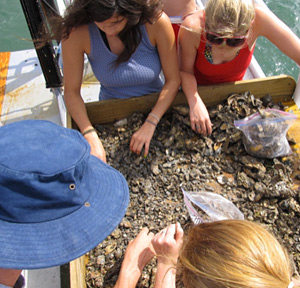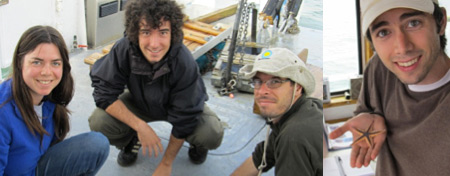
2011-2014: Higher-Taxon Fidelity: Comparative Taphonomy of Marine Benthic Associations in Holocene Depositional Systems of Coastal N. Carolina, $219,462

Project Overview
 Can death assemblages provide meaningful estimates of diversity, relative abundance and other aspects of local communities across multiple higher taxa simultaneously? Although most fossil assemblages consist of multiple higher taxa, we lack a clear understanding of whole assemblage fidelity, i.e., relative taphonomic biases across multiple higher taxa. Studies comparing living communities to sympatric death assemblages have been particularly fruitful in assessing biases induced by the fossilization process, and quantifying the expected fidelity of the resulting fossil record. However, these types of analyses are typically restricted to a single taxon, primarily more heavily calcified organisms such as mollusks. In an effort to quantitatively assess taphonomic biases across multiple marine invertebrate groups with variable biomineralization (bivalves, gastropods, echinoids, decapods, and chelicerates) we are targeting the subtidal benthos of coastal North Carolina.
Can death assemblages provide meaningful estimates of diversity, relative abundance and other aspects of local communities across multiple higher taxa simultaneously? Although most fossil assemblages consist of multiple higher taxa, we lack a clear understanding of whole assemblage fidelity, i.e., relative taphonomic biases across multiple higher taxa. Studies comparing living communities to sympatric death assemblages have been particularly fruitful in assessing biases induced by the fossilization process, and quantifying the expected fidelity of the resulting fossil record. However, these types of analyses are typically restricted to a single taxon, primarily more heavily calcified organisms such as mollusks. In an effort to quantitatively assess taphonomic biases across multiple marine invertebrate groups with variable biomineralization (bivalves, gastropods, echinoids, decapods, and chelicerates) we are targeting the subtidal benthos of coastal North Carolina.
Preliminary Results
 So far, dredging has resulted in the collection of 142 samples from 38 localities, and the identification of over 12,000 specimens representing 214 species. Our current data suggest that strong taphonomic filters can alter relative abundance of higher taxa and that while mollusk-based fidelity analysis provides a powerful tool for assessing anthropogenic changes, other groups with lower fossilization potential, may be less informative or more difficult to interpret in terms of human impacts on ecosystems. In addition to enhancing our understanding of the quality of the fossil record, this project could also provide an important reference baseline for conservation biology and community ecology where the assessment of anthropogenic changes in local ecosystems is essential for reconstructing pristine communities that existed prior to human-induced disturbances.
So far, dredging has resulted in the collection of 142 samples from 38 localities, and the identification of over 12,000 specimens representing 214 species. Our current data suggest that strong taphonomic filters can alter relative abundance of higher taxa and that while mollusk-based fidelity analysis provides a powerful tool for assessing anthropogenic changes, other groups with lower fossilization potential, may be less informative or more difficult to interpret in terms of human impacts on ecosystems. In addition to enhancing our understanding of the quality of the fossil record, this project could also provide an important reference baseline for conservation biology and community ecology where the assessment of anthropogenic changes in local ecosystems is essential for reconstructing pristine communities that existed prior to human-induced disturbances.
Related Publications
Tyler, C.L., & Kowalewski, M. 2013. The Utility of Marine Benthic Associations as a Multivariate Proxy for Paleo-Bathymetry: A Direct Test from Recent Coastal Ecosystems of North Carolina. GSA Abstracts with Programs 45(2):55.
Tyler, C.L., & Kowalewski, M. 2012. Live-Dead Fidelity of Multi-Taxic Assemblages: Relative Taphonomic Biases across Major Benthic Marine Invertebrate Groups (NC, USA). GSA Abstracts with Programs 44(7).
Kowalewski, M., & Tyler, C.L. 2012. A Multi-Taxic Evaluation of the Quality of the Fossil Record Based on Marine Benthic Associations of Coastal North Carolina. GSA Abstracts with Programs 44(7).
Tyler, C.L., Kowalewski, M, Hendy, A.J.W. 2012. Onshore-Offshore Trends in Marine Macrobenthic Communities in the Presence of Anthropogenic Impacts. GSA Abstracts with Programs 44(4):76.
Kowalewski, M., Tyler, C.L., Mack, K, Hendy, A.J.W. 2012. Anthropogenic & Bathymetric Determinants of Marine Benthic Associations in Coastal North Carolina. GSA Abstracts with Programs 44(4):76.
Mack, K., Tyler, C.L, & Kowalewski, M. 2012. Spatial Variation in Predation on Spisula solidissima across Recent Barrier Island Environments, Beaufort, North Carolina. GSA Abstracts with Programs 44(4)1:19.
Tyler, C.L., & Kowalewski, M. 2011. Live-Dead Fidelity of Multi-Taxic Assemblages: Relative Taphonomic Biases across Major Groups of Marine Benthos (North Carolina, USA). GSA Abstracts with Programs 43(5).
Tyler, C.L., & Kowalewski, M. 2008. Comparative Taphonomy of Marine Benthos: Quantitative Estimates of Higher-Taxon Fidelity in Marine Nearshore Systems of the Outer Banks, North Carolina. GSA Abstracts with Programs 40(6):102.